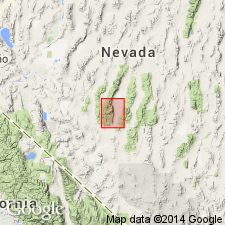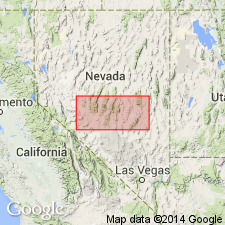
- Usage in publication:
-
- Pablo formation*
- Modifications:
-
- Named
- AAPG geologic province:
-
- Great Basin province
Summary:
Unit is named the Pablo formation of Pablo Creek, Toiyabe Range, NV. Consists of about 40 percent lavas and breccias, originally chiefly augite, andesite, now highly altered and in part albitized, and about 40 percent light-colored cherts grading into greenish siliceous rocks that are in part determinable as bedded tuffs. The remainder includes conglomerates, grits, and slates similar to those of the underlying Diablo formation except that the pebbles of the conglomerates contain a large proportion of igneous, both greenstone and felsite. Thickness probably exceeds 5000 ft. Age is Permian(?).
Source: GNU records (USGS DDS-6; Menlo GNULEX).

- Usage in publication:
-
- Pablo Formation*
- Modifications:
-
- Age modified
- AAPG geologic province:
-
- Great Basin province
Summary:
Age of the Pablo Formation is revised from Mississippian to: Permian(?) [based on regional stratigraphic relations and fossil data].
Source: GNU records (USGS DDS-6; Menlo GNULEX).
For more information, please contact Nancy Stamm, Geologic Names Committee Secretary.
Asterisk (*) indicates published by U.S. Geological Survey authors.
"No current usage" (†) implies that a name has been abandoned or has fallen into disuse. Former usage and, if known, replacement name given in parentheses ( ).
Slash (/) indicates name conflicts with nomenclatural guidelines (CSN, 1933; ACSN, 1961, 1970; NACSN, 1983, 2005, 2021). May be explained within brackets ([ ]).

